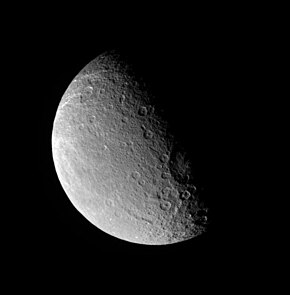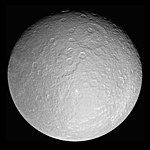Tirawa (crater)
 This Cassini image of Rhea shows Tirawa straddling Rhea's terminator | |
| Feature type | Peak-ring impact basin |
|---|---|
| Location | Leading hemisphere, Rhea |
| Coordinates | 34°12′N 151°42′W / 34.200°N 151.700°W[1] |
| Diameter | ~350 km (220 mi)[2] |
| Depth | ~6 km (3.7 mi)[2] |
| Discoverer | Voyager 1 |
| Eponym | Tirawa |
Tirawa is the largest impact basin on Saturn's moon Rhea. It was glimpsed by Voyager 1 during its flyby of the moon and later photographed in greater detail by the Cassini orbiter. Tirawa is elongated in shape and overlaps Mamaldi, a larger and more degraded basin to its southwest.[3]
Observation and naming
[edit]Tirawa was first observed by the Voyager 1 as it captured imagery of Rhea during its flyby of the Saturn system on 13 November 1980. Though poorly imaged from the Voyager 1 encounter, Tirawa was identified as an impact structure by 1983 and provisionally named Basin A.[4][3] Tirawa was later named after the primary deity in Pawnee mythology, Tirawa; the name was officially approved by the International Astronomical Union (IAU) in 1987.[1] Tirawa was later observed in greater detail by the Cassini orbiter in multiple flybys of Rhea throughout the late 2000's and the 2010's.
Geology
[edit]With a rough diameter of 350 kilometers, Tirawa is the largest identified impact structure on Rhea. Tirawa is a peak-ring impact basin, with a degraded inner ring of ridges and plateaus roughly 180 kilometers across. Individual ridges in the peak ring are typically ~50 kilometers across at their base and rise 1–3 kilometers above the basin floor. Tirawa is slightly elongated into an ellipsoid, with an a/b ratio of ~0.9, indicating that it was created in a low-angle oblique impact. Based on the crater counting method, Tirawa is about 4 billion years old.[2][4]
The impact event that created Tirawa ejected massive amounts of material, with up to ~15-20% of the material ejected at speeds exceeding Rhea's escape velocity.[2] Any such impact ejecta would've escaped Rhea's influence entirely, directly orbiting Saturn. Some of the ejecta later impacted Rhea, likely accounting for a large amount of Rhea's small craters.[5]
See also
[edit]References
[edit]- ^ a b "Tirawa". Gazetteer of Planetary Nomenclature. USGS Astrogeology Research Program. (Center Latitude: 34.20°, Center Longitude: 151.70°; Planetographic, +West)
- ^ a b c d Moore, Jeffrey M.; Schenk, Paul M.; Bruesch, Lindsey S.; Asphaug, Erik; McKinnon, William B. (October 2004). "Large impact features on middle-sized icy satellites". Icarus. 171 (2): 421–443. Bibcode:2004Icar..171..421M. doi:10.1016/j.icarus.2004.05.009.
- ^ a b Wagner, R. J.; Neukum, G.; Giese, B.; Roatsch, T.; Wolf, U. (March 2007). The Global Geology of Rhea: Preliminary Implications from the Cassini ISS Data (PDF). 38th Lunar and Planetary Science Conference. The Woodlands, Texas, United States. 1958. Archived (PDF) from the original on 3 March 2016. Retrieved 22 January 2008.
- ^ a b Moore, J. M.; Horner, V. M.; Greeley, R. (February 1985). "The geomorphology of RHEA - Implications for geologic history and surface processes". Journal of Geophysical Research. 90: C785–C795. Bibcode:1985LPSC...15..785M.
- ^ Leliwa-Kopystynski, Jacek; Banaszek, Marcin; Wlodarczyk, Ireneusz (January 2012). "Longitudinal asymmetry of craters' density distributions on the icy satellites". Planetary and Space Science. 60 (1): 181–192. Bibcode:2012P&SS...60..181L. doi:10.1016/j.pss.2011.08.002.
| Geography |
| |||||
|---|---|---|---|---|---|---|
| Discoverer | ||||||
| Exploration |
| |||||
| Related | ||||||
Text is available under the CC BY-SA 4.0 license; additional terms may apply.
Images, videos and audio are available under their respective licenses.

